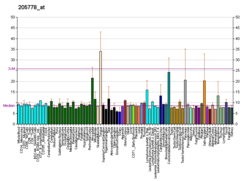Function
KLK7 is secreted as an inactive zymogen in the stratum granulosum layer of the epidermis, requiring proteolytic cleavage of the short N-terminal pro-region to liberate activated enzyme. This may be performed by KLK5 or matriptase, which are in vitro activators of KLK7. [11] [12]
Once active, KLK7 is able to cleave desmocollin and corneodesmosin. [13] These proteins constitute the extracellular component of corneodesmosomes, intercellular cohesive structures which link the intermediate filaments of adjacent cells in the stratum corneum. Proteolysis of corneodesmosomes is required for desquamation, the shedding of corneocytes from the outer layer of the epidermis. This indicates a role for KLK7 in maintaining skin homeostasis. For example, KLK7 expression is highly downregulated at acral surfaces where desquamation is delayed and the epidermis is thick. [14]
Both KLK5 and KLK14, other skin-expressed proteases, also cleave corneodesmosomal proteins. [13] KLK5 is able to undergo autoactivation, as well as activating KLK7 and KLK14, suggesting a KLK skin cascade is responsible for coordinating desquamation. [12]
KLK7 activity is regulated by a number of endogenous protein inhibitors including LEKTI, [15] [16] SPINK6, [17] elafin [18] and alpha-2-Macroglobulin-like 1. [19] Both Zn2+ and Cu2+ ions are also able to inhibit KLK7. [18]
KLK7 is a chymotrypsin-like serine protease, preferring to cleave proteins at the residues tyrosine, phenylalanine or leucine. [20] Analysis of peptide substrate hydrolysis indicates a strong preference for tyrosine at P1. [21]
This page is based on this
Wikipedia article Text is available under the
CC BY-SA 4.0 license; additional terms may apply.
Images, videos and audio are available under their respective licenses.





